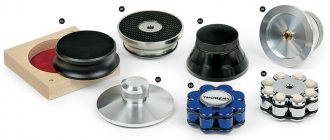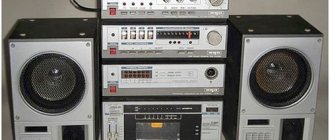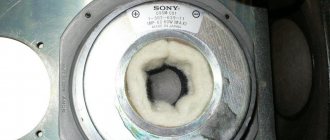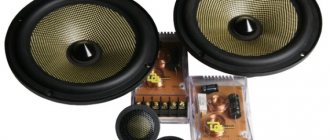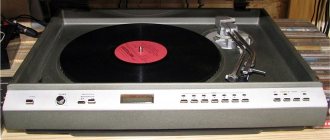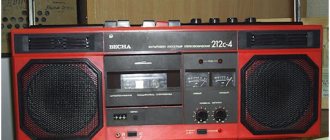The world is tirelessly and inexorably moving forward, everything that people use throughout their lives is modified, changed and complicated. The same applies to inspiring, supporting and inspiring fuel - music. Not only genres, tastes, styles change, but also methods of storing and transmitting music. Nowadays, playing music for the most part does not represent any ritual. What was it like before? In this article we will understand what a vinyl record is, what is the size of a vinyl record, and how it is used. Dedicated to all music lovers!
Why are vinyl records not going to leave the music media market?
Playing vinyl records is a real ritual, from the process of playing them to absorbing the sounds they give. Their owners can literally “touch” the music and feel its versatility. The design of the vinyl player and media takes you back to the past, gives a feeling of warmth and home comfort; discs are also often used as an element of the interior without losing them. Vintage vinyls, like time guides, take us to the era of Elvis Presley and Led Zeppelin and help us plunge into the culture of another time.
In addition to the emotional component of consuming music through records, there is also a rational one: they are highly durable, have excellent sound quality, and have small circulations, which increases the possibility that the original matrix was used.
This music transmission medium is not only not going away from the market, it is in great demand as a collectible item. The older the record, the more discophiles want to get it.
Revolutions
Recording at 45 rpm definitely improves sound quality by optimizing the noise-to-signal ratio (specifically, in the high-frequency spectrum).
But at the same time, the format reduces the amount of recording time on each side. It is for this reason that only singles and less often EPs are released at 45 rpm.
33 revolutions result in a longer recording. But the sound quality is reduced in quality, unfortunately. But not much. A newbie vinyl lover, for example, will definitely not understand the difference. But a more experienced audiophile will hear it right away. In addition, he knows that due to the narrow grooves of such a record, vinyl is more susceptible to deformation than discs of other formats.
At the moment, 33-rpm vinyl is usually used for publishing “heavy” albums, because you can’t fit all the music on a medium of a different format.
Wise publishers, in order to avoid reducing the sound quality on 33 rpm vinyl, do the following: they print the album of the group/performer not on 1 record, but on several (2 or 3). This is done in situations, for example, when the release is of great significance and at the same time very long duration, as well as a huge number of tracks. Thanks to this, it is possible to maintain decent sound quality and fit all the necessary tracks in one publication.
Recording at 45 rpm clearly improves sound quality by optimizing the noise-to-signal ratio
Types of records
Before purchasing, decide which material attracts you more.
Hard records come in shellac and gramophone formats. Shellac ones are heavy and quickly become unusable, gramophone ones are lighter, more durable and are not always made of shellac; they can also be plastic.
Flexible ones are usually not very roomy. Most often they were listened to in the USSR, and you could listen to 2 songs on each side.
Since records are also considered as a decorative element, it is logical to distribute special souvenir copies. They come in different colors and even shapes, and the size also varies at the discretion of the person who produces them.
Homemade records are underground and low-quality materials that became widespread in the 60s of the last century in the USSR, when hearts demanded change and Western sound, but there was no money.
Vinyl record groups
Vinyl copies are divided into two groups. We are talking about the following:
- antique original products;
- new reissues, which are also known as remakes.
The latter are of no value. Collectors and audiophiles don't buy them. In fact, these are not original products, but simply copies. Such remakes have worse sound and different lengths of music tracks. Any collector strives to buy vintage heavy vinyl, which pleases with its uniqueness and atmospheric sound.
Vinyl record size in centimeters
“Giant,” “grand,” “minion” are all musical terms. Let's understand their meaning.
What size vinyl record you choose depends on how much information is recorded on it. The first series were produced in the 1890s and had a diameter of 7 inches, that is, 175 mm. Double-sided vinyl discs became available at the beginning of the 20th century, at the same time the first 12-inch records, which is 300 mm, began to be produced. The most popular size was 10 inches or 250 mm. The fourth format is 8 inches or 185 mm.
The three most common sizes of vinyl that you can easily find in specialized stores - 12, 10 and 7 inches - correspond to the names “giant”, “grand” and “minion”.
DJs, collectors, and record fans use long-playing stereo copies with a diameter of 30 cm, which is the standard size of a vinyl record.
Types of records by manufacturer
Music on vinyl is also divided into groups depending on the manufacturer. The most popular options include the following.
- Soviet. These are mainly records that were made. There were also other products from competing factories. This category also includes records that were subsequently released in the post-Soviet space.
- Democrats. This is the name given to records previously produced in the countries of the socialist camp. These include Bulgaria, Poland and some others.
- Branded copies.
Accordingly, the price is different. The first category is considered the most affordable and has average sound quality. The reason is the large-scale production of products. But even there, sometimes you come across rare specimens at fairly high prices.
The second category also refers to inexpensive records. They also didn’t sound too good, but their prices today are more expensive than Soviet ones. Branded ones are the most expensive group, which includes those from Austria, Japan, Germany, and the USA.
How to play records?
Let's figure out what to do after purchasing a player and discs.
1. First, open the protective cover.
2. Then place the media on the rotating disk, press slightly so that it fits snugly against it.
3. Turn on the switch (lever near the disk).
4. Raise the tonearm (stylus) and place it smoothly before the start of the first track on your record, unless the turntable does this for you automatically after turning it on.
5. Enjoy real, live music.
6. After listening, return the tonearm to its original place and protect the player with a case or cover.
Recording sound on a record[edit]
The sound from a magnetic phonogram, using special equipment, is converted into mechanical vibrations of the cutter, thanks to which concentric sound grooves are applied to the thinnest layer of copper covering a perfectly flat steel substrate. This technology is still used today and is known as DMM (Direct Metal Mastering). This copper disk is designed to obtain from it by electroplating in several successive stages the required number of nickel copies with both positive and negative display of the mechanical phonogram. The negative copies made at the last stage are called matrices, which serve as the basis in the process of pressing gramophone records; all intermediate nickel copies are usually called originals. The galvanic shop produces originals and matrices. Electrochemical processes are carried out in multi-chamber galvanic installations with automatic stepwise regulation of electric current and nickel build-up time with a special electrolyte composition. The material for making a gramophone record is a special mixture based on a copolymer of vinyl chloride with vinyl acetate and various additives to give the plastic the necessary mechanical-temperature properties and electro-acoustic parameters. High quality mixing of powdery components is achieved using two-stage mixers with hot and cold mixing. Mold parts are manufactured on numerically controlled machines and undergo high-temperature soldering in vacuum ovens using special technology. The molds themselves ensure high uniformity of the temperature field on the forming surfaces, low inertia of the temperature regime, and therefore high productivity. Tens of thousands of records can come out of one mold. In the press shop, a hot mixture of plastic spreads between the two halves of the mold, as if absorbing invisible sound grooves. The first gramophone record produced after installing nickel dies on the press, and then each specially selected one from the circulation, are carefully checked for dimensional characteristics and listened to in specially equipped sound booths. To avoid warping, all pressed records undergo the required temperature exposure.
Process of playing a vinyl record
Playing music through a disc seems like real, inexplicable magic. In fact, physicists explain everything very simply. Under the influence of sound, the microphone membrane of recording equipment vibrates. Acoustic vibrations are recorded, they are transferred to the surface of the plate - spiral grooves are cut. Under a microscope you can see that these are not straight lines, but waves and zigzags. This is how sound tracks appear. During playback, the needle moves along the track, and it begins to vibrate. The pickup reads these vibrations and transmits them to the speaker, whose membrane vibrates. Thus, sound is created under the needle.
Operating principle[edit]
The sound from a gramophone record is extracted using the needles of devices specially created for this purpose - first gramophones, then electrophones or electric players. As you move along the convolutions of the record track, the needle begins to vibrate. This vibration, in turn, produces an electrical signal identical to the signal picked up by a microphone in a recording studio. In modern audio devices, this signal passes through a phono preamplifier, an amplifier, and becomes audible through the speakers.
How long does it take to play a vinyl record?
In terms of size in terms of capacity, the first 7-inch format was quite modest. It contained 2 minutes of material on one side. The 10-inch ones contained a fragment one and a half times larger. 12" - 5 minutes on both sides. 8-inch records, which were actively used in the USSR, contained large materials.
With the development of technology, longer files were placed on vinyl, so-called “long-playing” materials appeared that can be listened to for about an hour.
About inches
You all probably know that there are disk formats such as 7″ (inches), 10″ (inches) and 12″ (inches).
So 10″-inch records are a kind of “dinosaur” of the vinyl era. As a rule, all 78-rpm gramophone records are classified as such. Such discs contained only 2-3 minutes of sound on each side, and nothing more.
This format was followed by 7″ and 12″ inch vinyl. Each of these options was developed by a specific record company pursuing its own specific goals.
For example, the mission of 7″ inches was to maintain the best sound quality with the smallest vinyl sizes. Therefore, such records, created at 45 rpm, contained the same number of compositions as their 78-rpm 10″-inch counterparts.
So it happened that 7″ inch discs became singles with 3-minute compositions on each side of the vinyl. This has become a generally accepted global standard.
7″-inch discs have become the standard of quality and simply normal in the recording industry. But there is always an exception to even the most solid rule, right? And this was the exception...
She was somehow able to produce 7" 33 rpm vinyls with 2 tracks on each side. It would be better to simply remain silent about the sound quality of such publications. True, this was a long time ago and few people remember about it. But a fact is a fact.
It is curious that since those epoch-making times of vinyl format battles, seven-inch discs have also been produced with a larger hole in the center. This type of record was used in jukeboxes (jukeboxes). For such vinyl, a round adapter was used, which, as a rule, was included free of charge with the player.
Vinyl may also differ in its design: images, illustrations, photos, etc.
Today, seven-inch records are produced with a hole of a regular, standardized diameter, or the vinyl has a special insert that can be easily pulled out and thereby create a larger hole in the disc.
As for 12″-inch vinyl discs, they began to be produced due to the need to publish releases with a total playing time of 40 minutes on both sides (based on 20 minutes for each side). Thus, the main competitor of magnetic tape was born.
Later, 12″ inch singles with 2-3 tracks began to be published at both 45 and 33 rpm. By and large, these were the same 7″ inch vinyl discs, but with a higher quality sound. The reason for the increase in sound level was the size of the disc. It made it possible to make recording grooves as wide as possible and with a longer sound duration.
What is the size of a vinyl record in a sleeve?
It is worth noting that the material of envelopes varies. There are regular paper envelopes and thicker envelopes, such as polypropylene or polyethylene. In addition, there are external bags that are made to provide greater protection from external influences.
The size of a vinyl record in a package depends on the diameter of the record itself. For a 12-inch diameter, an envelope of 32.5 * 32.5 cm will fit, for a 10-inch medium, an envelope of 26 * 26.5 cm will fit, 7 inches will fit into an envelope of 18.5 * 18.5 cm.
That is, the question about the size of a vinyl record sleeve in cm cannot be given an unambiguous answer; it can be different.
The price of the envelope depends entirely on your requirements. A regular paper envelope costs about 60 rubles, a thicker one costs 90 rubles per piece.
Mono and stereo records[edit]
Monaural records use only horizontal stylus vibrations, while stereo records use both horizontal and vertical stylus vibrations. The sum of two audio channels is encoded horizontally, and their difference vertically, which ensures full compatibility (monaural players reproduce stereo records as the sum of channels, and stereo players reproduce monophonic recordings as two identical channels).
Most stereo records are recorded at 33 1/3 rpm with a 55 µm audio track width. Previously, records with a rotation speed of 45 rpm were widely produced. They were, in particular, used in jukeboxes with automatic change or selection of records. To record speech programs, records were produced with a rotation speed of 8 1/3 rpm and a playing time of up to one and a half hours on one side.
The records come in three diameters: 175, 250 and 300 mm, which provides an average playing time of one side at 33 1/3 rpm of 7-8, 13-15 and 20-24 minutes. The duration of the sound depends on the cutting density. A tightly cut record can hold up to 30 minutes of music on one side, but the stylus on such records can jump and be generally unstable. Such records wear out faster due to the narrower groove walls. In relation to records used by DJs, we can say that about 12 minutes of music are cut per side. In this case, the distance between the grooves is much larger, the plate is more wear-resistant, makes less noise over time, and is not afraid of scratching and careless handling. The hole diameter of the record is 7 or 24 mm, thickness varies from 1.5 to 3 mm, weight 120-220 g. The color of gramophone records is mostly black, although multi-colored ones are often produced for children and DJs. Decorative plates can be square, hexagonal, in the form of a circular saw blade, as well as in the shape of animals and birds.
What is the cost of a vinyl record?
The price is influenced by a number of factors, such as the country of origin, method of production, rarity, general condition, circulation, speed of turnover. The smaller the circulation of a record and the more revolutions it has, the more expensive it is.
The best vinyls can cost over one hundred thousand rubles per piece. The most expensive record is considered to be the record of the legendary group The Beatles.
The cost of regular, non-limited vinyls varies from 600 to 10,000 rubles.
Directions of music on vinyl
Various types of music are recorded on vinyl. The most popular among them include the following:
- metal;
- electronics;
- pop rock;
- jazz;
- rock;
- classic;
- blues;
- soul;
- funk.
There are variations depending on how vinyl is recorded. Previously, this was a whole procedure for the production of a motherboard, which was taken as a basis and multiplied. If copies were used to produce records, the sound quality dropped significantly. At the same time, the diameter of the vinyl record and other characteristics were carefully observed, but the quality itself dropped slightly.
Inner envelope material
Everything is simple here - no polyvinyl chloride, also known as PVC. It is believed that this material can cause irreparable harm to vinyl in the form of whitish spots and a noticeable “hissing” effect. High-strength polyethylene (HDPE) inner envelopes are much better to use.
Well, the ideal option is considered to be “sandwiches” of three layers of HDPE with one inner layer of acid-free paper, often rice paper. A plate is placed between two layers of HDPE, and between the two adjacent layers there is a sheet of rice or any other acid-free paper, the purpose of which is to absorb moisture and remove static electricity.
Of course, the described “sandwiches” are the highest aerobatics in the production of inner envelopes, and therefore their cost is appropriate. If you want to save a little money, you can take square paper sleeves with HDPE inner layers, between which the record will be stored.
Principles for choosing inner envelopes
Invest In Vinyl 50 LP Inner Sleeves
Quite simple square inner envelopes, in the design of which they did not forget to put a marking indicating the cut for inserting the record.
These sleeves are slightly thicker than generally accepted standards, which should provide better protection for the records, according to the manufacturer. Amazon
Square Deal Anti-Static HDPE with Rice Paper Inner Sleeves
Inner sandwich envelopes made of antistatic, acid-free high-density polyethylene.
To give additional rigidity and absorb moisture, rice paper acts as one of the layers. The highlight is the small edge in the cut area, which makes inserting the record into the envelope much more convenient. Amazon
Mobile Fidelity Sound Lab Inner Sleeves
MoFi has been offering vinyl lovers the gold standard inner sleeve for 35 years, used by most reviewers and serious collectors.
An uncompromising solution for those who are not bothered by any costs for storing their collection. These inner sleeves aren't cheap, but they're virtually flawless. Amazon
BCW 12″ Paper & Plastic Polylined Record Inner Sleeves
These heavy-duty inner envelopes consist of an inner layer of polyethylene and an outer layer of paper.
This design ensures both the safety of vinyl grooves and increased impact resistance in case of accidental falls of records, from which no one is safe. Amazon
Hudson Hi-Fi Anti-Static Vinyl Record Inner Sleeves
Among the manufacturer's bravura statements, the main thing can be identified: these are high-quality multi-layer envelopes with rice paper as a seal.
And if they are not too different in quality from similar products from competitors, then for true collectors there is an option to purchase 500 envelopes at once with a very noticeable discount. Amazon
How to buy and place an order on Amazon for delivery if you've never done it.
History of the gramophone record
The most primitive prototype of a gramophone record can be considered a music box, in which a metal disk with a deep spiral groove is used to pre-record a melody. In certain places of the groove, pinpoint depressions are made - pits, the location of which corresponds to the melody. When the disk rotates, driven by a clock spring mechanism, a special metal needle slides along the groove and “reads” the sequence of applied dots. The needle is attached to a membrane, which makes a sound every time the needle hits a groove. The oldest gramophone record in the world is now considered to be a sound recording that was made in 1860. Researchers from the recording history group First Sounds discovered it on March 1, 2008, in a Paris archive and were able to play an audio recording of a folk song made by French inventor Edouard-Léon Scott de Martinville using a device he called a “phonautograph” in 1860. It is 10 seconds long and is an excerpt from a French folk song. The phonoautograph scratched sound tracks on a sheet of paper blackened by smoke from an oil lamp.
In 1877, the French scientist Charles Cros was the first to scientifically substantiate the principles of recording sound on a drum (or disk) and its subsequent playback. In the same year, namely in the middle of 1877, the young American inventor Thomas Edison invented and patented a phonograph device in which sound is recorded on a cylindrical roller wrapped in tin foil (or paper tape coated with a layer of wax) using a needle (cutter) , associated with the membrane; the needle draws a helical groove of variable depth on the surface of the foil. His wax roller phonograph was not widely used due to the difficulty of copying the recording, the rapid wear of the rollers, and poor playback quality. In 1887, the German engineer Emil Berliner proposed using a disk-shaped medium for recording. Working on his idea, Berliner first built and tested Charles Cros' device, proposed 20 years ago, using a zinc plate instead of a chrome one. Emil Berliner replaced the rollers with disks - metal matrices from which copies could be made. With their help, gramophone records were pressed. One matrix made it possible to print an entire circulation - at least 500 records, which significantly reduced production costs and, accordingly, the cost of production. This was the main advantage of Emil Berliner's gramophone records compared to Edison's wax rollers, which could not be mass-produced. Unlike Edison's phonograph, Berliner developed a special device to record sound - a recorder, and to reproduce sound he created another - a gramophone, for which a patent was received on September 26, 1887. Instead of Edison's depth recording, Belinger used transverse recording, in which the needle left a sinuous trace of constant depth. In the 20th century, the membrane was replaced by microphones that convert sound vibrations into electrical vibrations, and by electronic amplifiers.
In 1892, a method was developed for galvanic replication of a zinc disk from a positive, as well as a technology for pressing ebonite records using a steel printing matrix. But ebonite was quite expensive and was soon replaced by a composite mass based on shellac, a wax-like substance produced by tropical insects from the family of lac bugs that live in southeast Asia. The plates became of better quality and cheaper, and therefore more accessible, but their main drawback was their low mechanical strength - they resembled glass in their fragility. Shellac records were produced until the middle of the 20th century, until they were supplanted by even cheaper ones - made of polyvinyl chloride or “vinyl”.
Peculiarities
The very first records had a diameter of 6.89 inches and were called 7-inch or 175 mm records. This oldest standard dates back to the early 1890s. These gramophone records are designated as 7″, where “” is the designation of the diameter in inches. At the beginning of their evolution, gramophone records had a high rotation speed and a thick track, which significantly reduced the duration of the sound - only 2 minutes on one side. Double-sided records became available in 1903, thanks to developments. In the same year, the first 11.89 or 12 inch (12″) gramophone records with a diameter of 300 mm appeared. Until the early 10s of the 20th century, they mainly released excerpts from the works of musical classics, since they contained only up to five minutes of sound in total.
The third, most popular, size was 10 inches (10″) or 250 mm; such plates held one and a half times more material than the standard 7-inch plate. The “life” of such records was short-lived - the pickup weighed more than 100 grams, and the steel needles had to be changed after each side played. Sometimes, in order to extend the life of favorite works, the same track was recorded on both sides of some records. At the end of the 20s of the 20th century, the first revolution took place in the world of recording, when instead of the method of recording through a horn, they began to use the electroacoustic method - through a microphone. By reducing distortion, the frequency range has expanded from 150-4000 to 50-10000 Hz. In the 30s of the 20th century, records were released one composition on one side, and often one concert of one artist was sold as a set of records of several pieces, often in cardboard, less often in leather boxes. Due to the external similarity of such boxes with photo albums, they began to be called record albums or an album with recordings.
Second revolution
In 1948, the largest at that time and one of the oldest in the United States for the first time released the so-called long-playing record or Long Play (LP). The release of the long-play was dictated mainly by the competition with magnetic audio media, which at that time were magnetic tapes in reels or reels. In order to compete on price with tapes or not to lose sound quality, a new material was invented - vinylate. Long-playing records or long-plays were intended for electro-acoustic playback using electric players, electrophones, and later more compact radios. This invention made it possible to significantly expand the band of recorded frequencies from 50 to 16000 Hz, completely preserve the timbre of the sound, and also increase the dynamic range of recording to 50-57 dB, reduce the noise level, and greatly extend high-quality sound. The advent of electric pickups working with an amplifier made it possible to relieve the needle and make it possible to make it thinner, resulting in a decrease in the width of the groove and a decrease in the rotation speed of the disc. In 1949, RCA developed its own alternative phonograph record standard with a diameter of 175 mm with a large central hole and a rotation speed of 45 rpm. They found greatest use on jukeboxes and were distributed mainly in the USA. In the USSR, long-playing records began to be produced in 1950. In the same year, long-playing records with variable recording pitch appeared in the world, which made it possible to increase the recording duration by another 30% (33 rpm). In the USSR, such records began to be produced only in 1956. With the advent of long-playing gramophone records with a rotation speed of 45 and 33 rpm. The circulation of fast ones (78 rpm) began to decrease, and in the late 60s. their production was completely curtailed (in the USSR in 1970).
Depending on the contents of the record at 45 rpm. the titles Single, Maxi-Single or Extended Play (EP) were used.
Manufacturing
The sound from a magnetic phonogram, using special equipment, is converted into mechanical vibrations of the cutter, thanks to which concentric sound grooves are applied to the thinnest layer of copper covering a perfectly flat steel substrate. This technology is still used today and is known as DMM (Direct Metal Mastering). This copper disk is designed to obtain from it by electroplating in several successive stages the required number of nickel copies with both positive and negative display of the mechanical phonogram. The negative copies made at the last stage are called matrices, which serve as the basis in the process of pressing gramophone records; all intermediate nickel copies are usually called originals. The galvanic shop produces originals and matrices. Electrochemical processes are carried out in multi-chamber galvanic installations with automatic stepwise regulation of electric current and nickel build-up time with a special electrolyte composition. The material for making a gramophone record is a special mixture based on a copolymer of vinyl chloride with vinyl acetate and various additives to give the plastic the necessary mechanical-temperature properties and electro-acoustic parameters. High quality mixing of powdery components is achieved using two-stage mixers with hot and cold mixing. Mold parts are manufactured on numerically controlled machines and undergo high-temperature soldering in vacuum ovens using special technology. The molds themselves ensure high uniformity of the temperature field on the forming surfaces, low inertia of the temperature regime, and therefore high productivity. Tens of thousands of records can come out of one mold. In the press shop, a hot mixture of plastic spreads between the two halves of the mold, as if absorbing invisible sound grooves. The first gramophone record produced after installing nickel dies on the press, and then each specially selected one from the circulation, are carefully checked for dimensional characteristics and listened to in specially equipped sound booths. To avoid warping, all pressed records undergo the required temperature exposure, and before packaging in an envelope, the appearance of each record is checked.
How to distinguish between different types?
Shellac (gramophone) records cannot be played on electric phones, with the exception of those equipped with a rotating stylus marked “78” on one side. Otherwise, the needle will immediately become unusable.
Vinyl (long-playing and stereo) and flexible records are intended only for electrophones. Playing such a record on a gramophone will immediately and forever destroy the record. Therefore, it is important to distinguish between types of records. Gramophones are thicker, heavier, and more fragile (like glass). Vinyl (or flexible) records produced in the USSR are marked with an inverted triangle (mono) or intersecting circles (stereo). Further in the text, only vinyl and flexible records are considered.
Records "on the bones"
In the USSR in the 50s and 60s of the 20th century, individual recording studios recorded musical works, which for ideological reasons were not reproduced, on large-format X-ray films. This is where the expression “Jazz on the bones” came from (also, such “homemade” recordings were commonly called “ribs” or “records on ribs”). In those years, recordings of many singers and musical groups, for example, the Beatles, could only be heard on such semi-legal underground records. This original method of sound recording is reflected in art, for example, in Viktor Tsoi’s song “Once You Were a Beatnik” there are the words: “You were ready to give your soul for rock and roll, extracted from a photograph of someone else’s diaphragm.” The process of recording “on bones” was demonstrated in the film “Hipsters” directed by Valery Todorovsky (original title: “Rock on Bones”).
Formats
Various formats of gramophone records: 30 cm with 45 rpm, 25 cm with 78 rpm and 17.5 cm with 45 rpm. Records were mainly produced with a diameter of 30, 25 and 17.5 cm (Soviet designations: “∅300”, “∅250” and “∅175”) (12″, 10″ and 7″). Other sizes are occasionally found - 12, 15, 23, 28, 33 cm (5″, 6″, 8″, 9″, 11″, 13″).
Most of the records were rigid, but there were also flexible ones (often pasted into magazines as a sound supplement. An example is the Krugozor magazine). Flexible records are also recorded on old x-rays (see section above). The rotation speed can be 78, 45, 33⅓ and 16⅔ rpm.
Stereo records
Monaural records use only horizontal stylus vibrations, while stereo records use both horizontal and vertical stylus vibrations. The sum of two audio channels is encoded horizontally, and their difference vertically, which ensures full compatibility (monaural players reproduce stereo records as the sum of channels, and stereo players reproduce monophonic recordings as two identical channels). Most stereo records are recorded at 33 1/3 rpm with a 55 µm audio track width. Previously, records with a rotation speed of 45 rpm were widely produced. They were, in particular, used in jukeboxes with automatic change or selection of records. To record speech programs, records were produced with a rotation speed of 8 1/3 rpm and a playing time of up to one and a half hours on one side.
The records come in three diameters: 175, 250 and 300 mm, which provides an average playing time of one side at 33 1/3 rpm of 7-8, 13-15 and 20-24 minutes. The duration of the sound depends on the cutting density. A tightly cut record can hold up to 30 minutes of music on one side, but the stylus on such records can jump and be generally unstable. Such records wear out faster due to the narrower groove walls. In relation to records used by DJs, we can say that about 12 minutes of music are cut per side. In this case, the distance between the grooves is much larger, the plate is more wear-resistant, makes less noise over time, and is not afraid of scratching and careless handling. The hole diameter of the record is 7 or 24 mm, thickness varies from 1.5 to 3 mm, weight 120-220 g. The color of gramophone records is mostly black, although multi-colored ones are often produced for children and DJs. Decorative plates can be square, hexagonal, in the form of a circular saw blade, as well as in the shape of animals and birds.
Present tense
As of 2009, gramophone records and record players are not widely produced or used, having been replaced by more convenient and durable media. However, vinyl records are still used in certain areas. For example, lovers of high-quality analog sound, collectors and simply fans of this type of sound recording.
Nevertheless, it is too early to give up on the development of the vinyl industry. According to the RIAA, vinyl sales have now passed their low point in 2005 and are showing fairly steady annual growth.
AudioToys Delux Sleeve white / black
Double-layer inner bags for vinyl discs. The outer layer of thick paper ensures long service life and ease of use. The inner layer of high-density polyethylene HDPE with a thickness of 25 microns provides excellent dust protection and antistatic effect.
Size: 305 x 310 mm Pack of 25 pcs. Weight of one package: 21 g. Package weight: 555 g. Colors: white, black.



